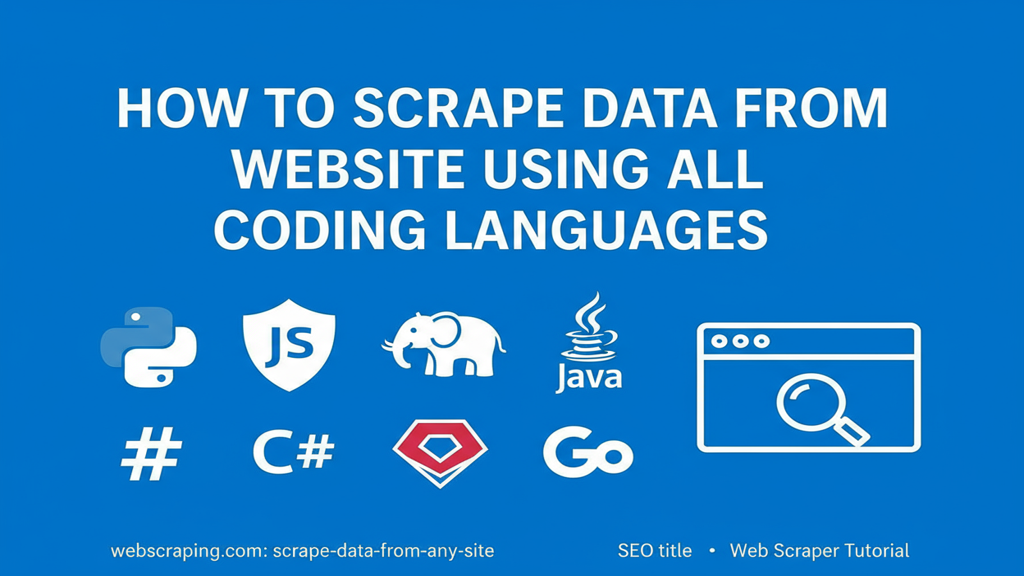In the era of data-driven decisions, web scraping has become a powerful technique for collecting information automatically from websites. Whether you’re a developer, data analyst, or digital marketer, learning how to scrape data from websites can save time and unlock valuable insights.
In this guide, we’ll explain how to scrape data using different programming languages like Python, JavaScript, PHP, and more — with tools, code examples, and best practices.
What Is Web Scraping?
Web scraping means extracting information from websites automatically using a script or software. Instead of manually copying data, web scraping allows you to:
- Collect product prices,
- Monitor competitor websites,
- Gather news or articles, and
- Build large datasets efficiently.
Example:
Suppose you want the latest product prices from Amazon. With web scraping, you can write a script that fetches this data automatically — saving hours of manual work.
How Web Scraping Works
Web scraping follows a simple workflow:
- Send HTTP Request: Access the webpage URL.
- Fetch HTML Content: Get the source code of the page.
- Parse Data: Extract specific tags (like titles, prices, links).
- Store Data: Save extracted data in CSV, Excel, or Database.
Best Languages for Web Scraping
There’s no single “best” language — each has its own advantages. Let’s look at the most popular programming languages for scraping data.
1. Web Scraping Using Python
Python is the most widely used language for scraping websites due to its easy syntax and powerful libraries.
Common Python Libraries:
- Requests – for sending HTTP requests
- BeautifulSoup – for parsing HTML
- Scrapy – for large-scale scraping
- Selenium – for dynamic content (JS-rendered pages)
Example Code:
import requests
from bs4 import BeautifulSoup
url = 'https://example.com'
response = requests.get(url)
soup = BeautifulSoup(response.text, 'html.parser')
for title in soup.find_all('h2'):
print(title.text)
Read more on BeautifulSoup Documentation
2. Web Scraping Using JavaScript (Node.js)
JavaScript is ideal for scraping dynamic websites that load content with AJAX or React.
Popular JS Tools:
- Axios – for fetching data
- Cheerio – for HTML parsing
- Puppeteer – for headless browser automation
Example Code:
const axios = require('axios');
const cheerio = require('cheerio');
axios.get('https://example.com').then(response => {
const $ = cheerio.load(response.data);
$('h2').each((i, elem) => {
console.log($(elem).text());
});
});
Use Puppeteer for complex sites like Amazon or LinkedIn where data loads dynamically.
3. Web Scraping Using PHP
PHP is perfect for developers managing server-side applications or WordPress-based automation.
🔧 Common PHP Tools:
- cURL – for HTTP requests
- DOMDocument – for parsing HTML
Example Code:
<?php
$url = 'https://example.com';
$html = file_get_contents($url);
$doc = new DOMDocument();
@$doc->loadHTML($html);
$tags = $doc->getElementsByTagName('h2');
foreach ($tags as $tag) {
echo $tag->nodeValue . "<br>";
}
?>
You can also integrate with WordPress using WP-Cron to automate scraping.
4. Web Scraping Using Java
Java offers powerful scraping with Jsoup, a popular library for HTML parsing.
Example Code:
import org.jsoup.Jsoup;
import org.jsoup.nodes.Document;
import org.jsoup.select.Elements;
public class WebScraper {
public static void main(String[] args) throws Exception {
Document doc = Jsoup.connect("https://example.com").get();
Elements titles = doc.select("h2");
for (var title : titles) {
System.out.println(title.text());
}
}
}
Learn more at Jsoup Official Site.
5. Web Scraping Using R
R is widely used in data science and statistical analysis — and it supports scraping too.
Example Code:
library(rvest)
url <- 'https://example.com'
page <- read_html(url)
titles <- page %>% html_nodes('h2') %>% html_text()
print(titles)
📊 You can then analyze scraped data using ggplot2 or export it as CSV.
Bonus: Web Scraping Using No-Code Tools
If you’re not a programmer, don’t worry!
Several tools allow you to scrape websites visually — no code required.
Popular No-Code Scraping Tools:
These tools let you select elements visually and export data in CSV, Excel, or JSON format.
How to Store and Use Scraped Data
Once you’ve extracted data, you can:
- Save it in CSV/Excel
- Store it in a database (MySQL, MongoDB)
- Use it for price comparison, trend analysis, or machine learning
💡 Pro Tip: Always clean your scraped data using Python Pandas or Excel before analysis.
Legal & Ethical Considerations in Web Scraping
Before scraping any site, always check its robots.txt file and Terms of Service.
Avoid scraping:
- Password-protected pages
- Personal or confidential data
- Government or medical portals
Only scrape publicly available information and use responsibly.
Best Practices for Efficient Web Scraping
- Add User-Agent headers to avoid blocking.
- Use delays or random intervals between requests.
- Handle CAPTCHAs or rate limits smartly.
- Cache previously fetched data.
- Use Proxies or Rotating IPs for large-scale scraping.
Useful Resources (Internal + External Links)
- Internal: Learn Python Programming – gyaando.com
- External: Scrapy Official Docs
- 💡 Internal: Top 10 AI Tools for Data Analysis
Conclusion: Start Web Scraping Like a Pro
Learning how to scrape data from websites is an essential skill in 2025. Whether you use Python, JavaScript, PHP, or Java, the goal remains the same — collect and analyze information efficiently.
Start small — scrape simple sites, analyze your results, and scale as you grow.
Remember: ethical scraping keeps the internet fair and valuable for everyone.
If you’re ready to automate your next data project, check out our guide:
Top Python Automation Projects for Beginners 2025



